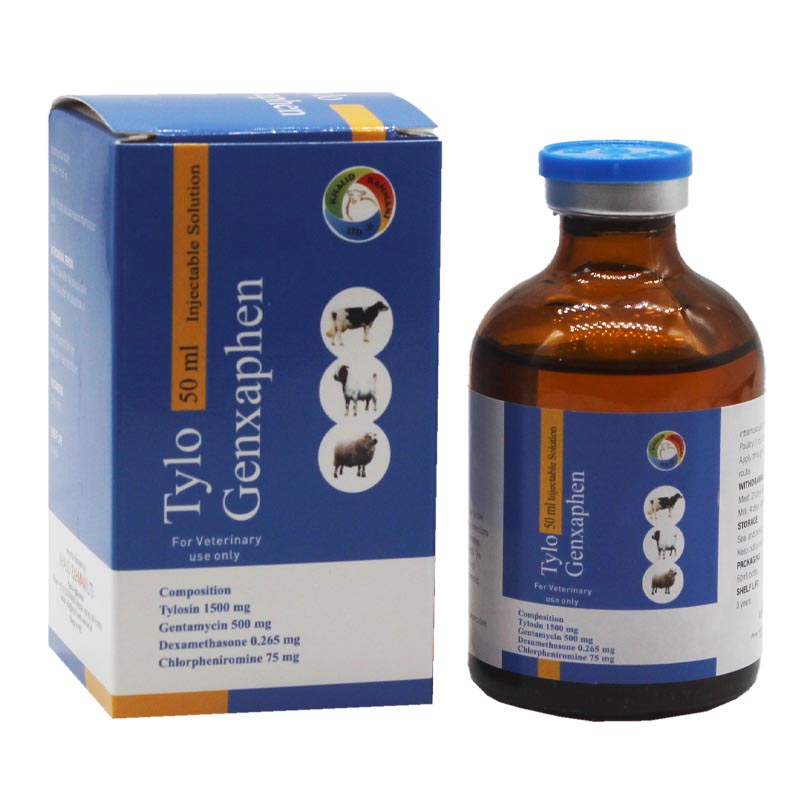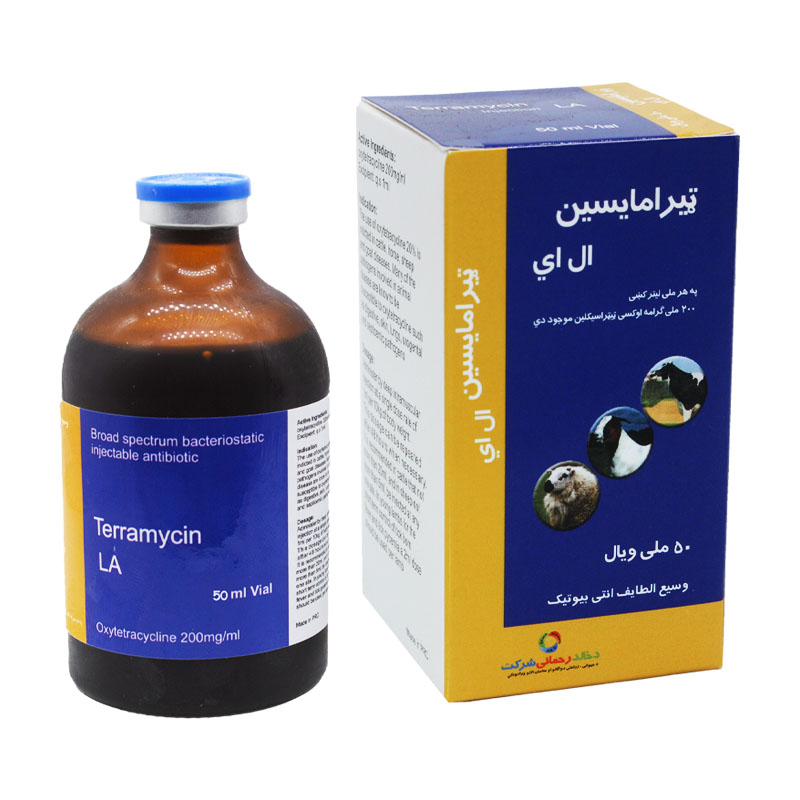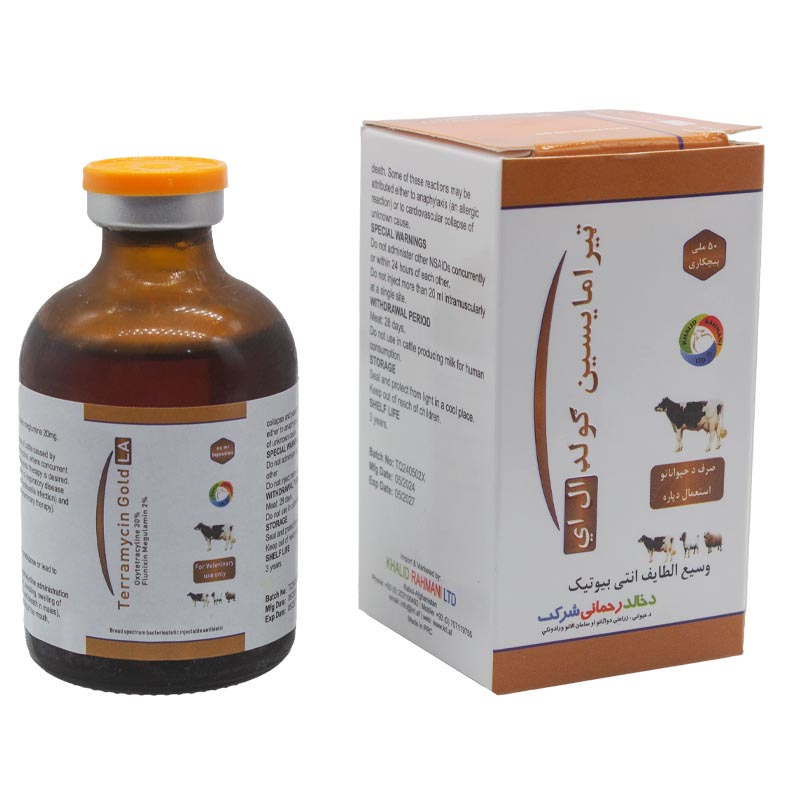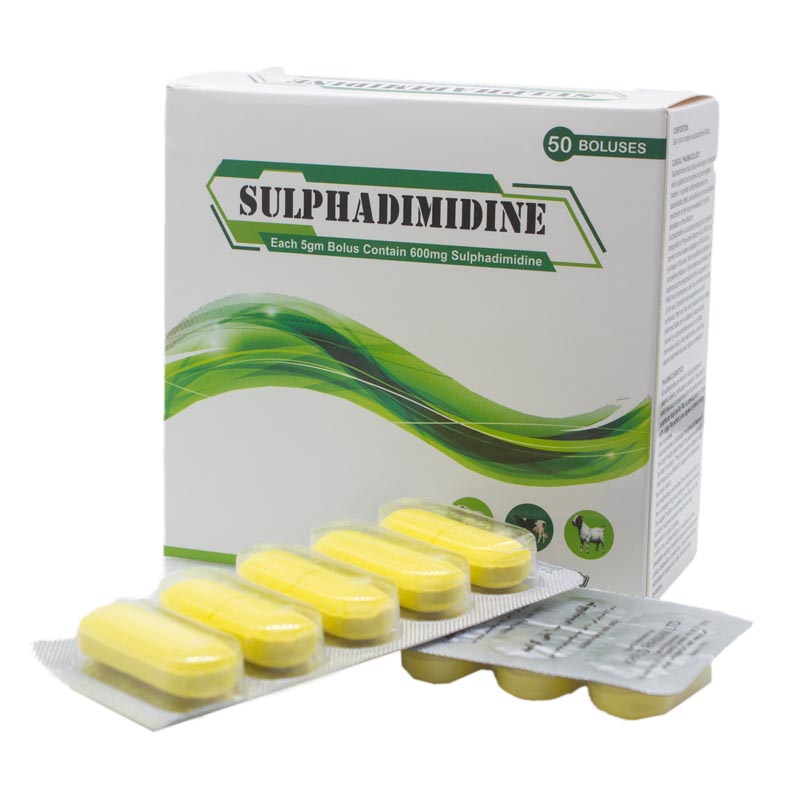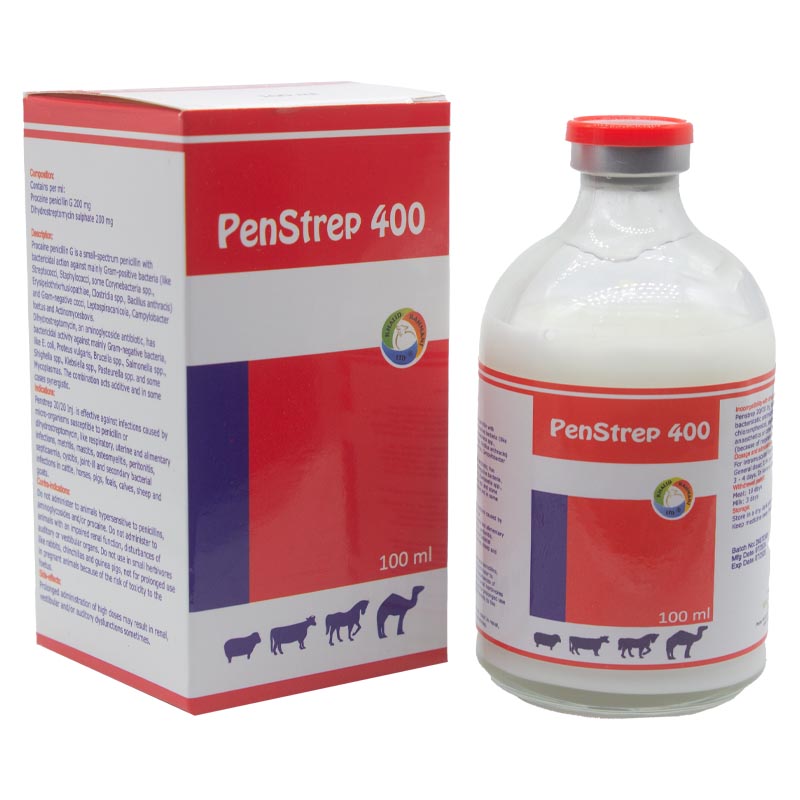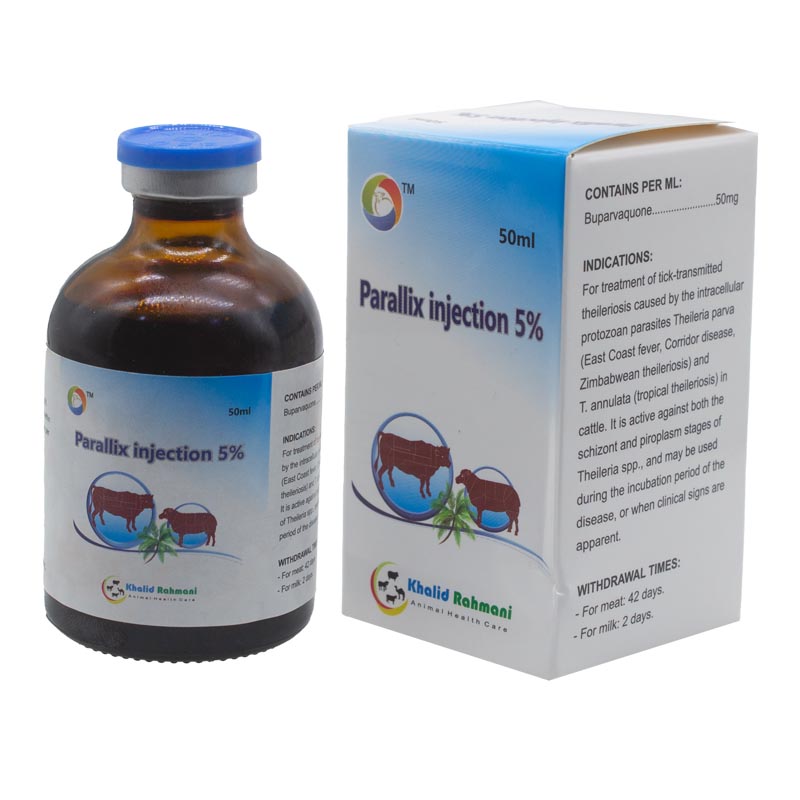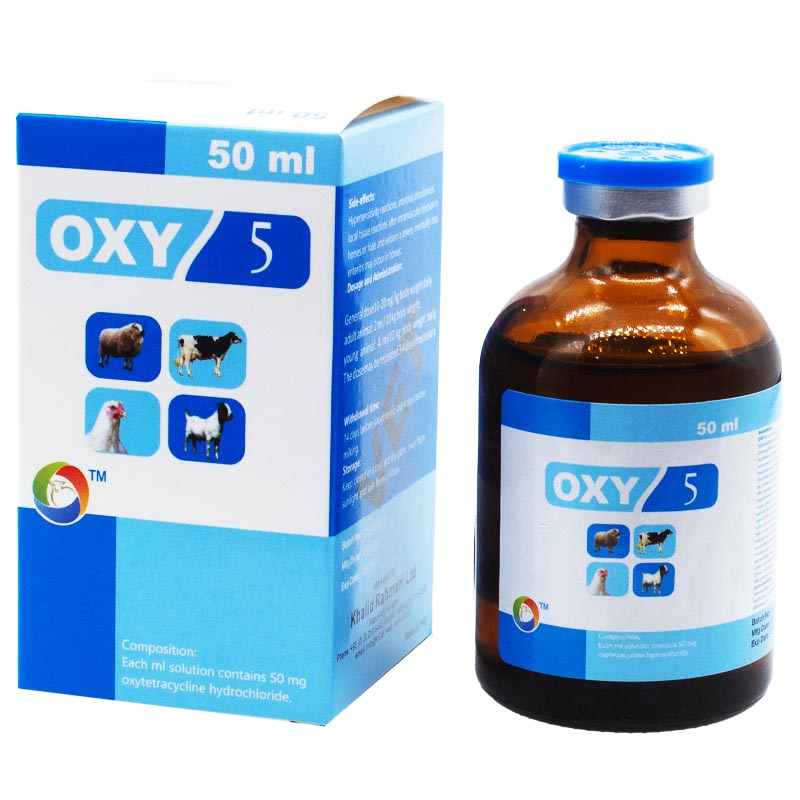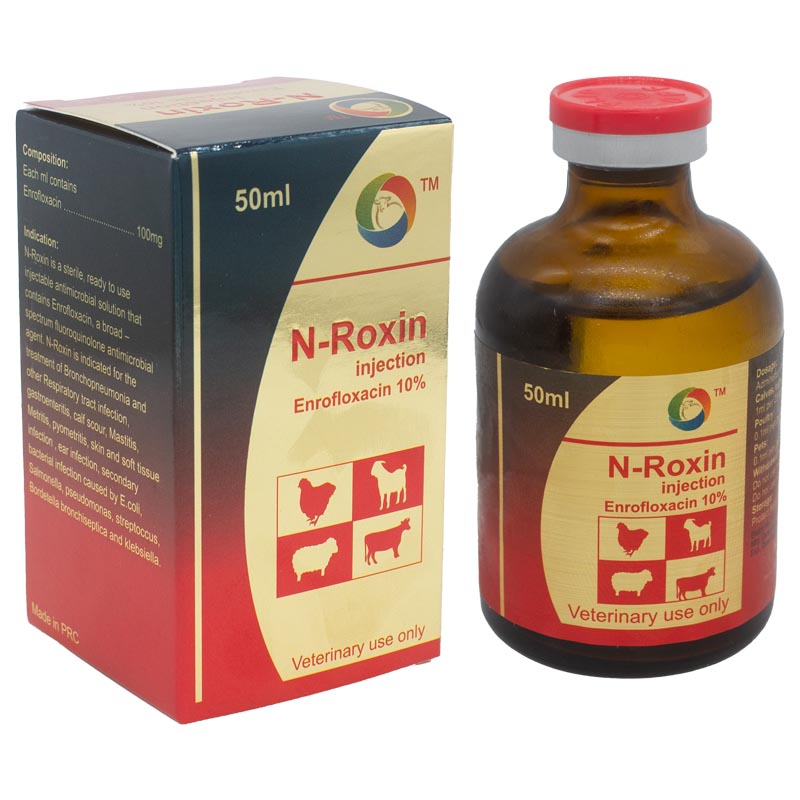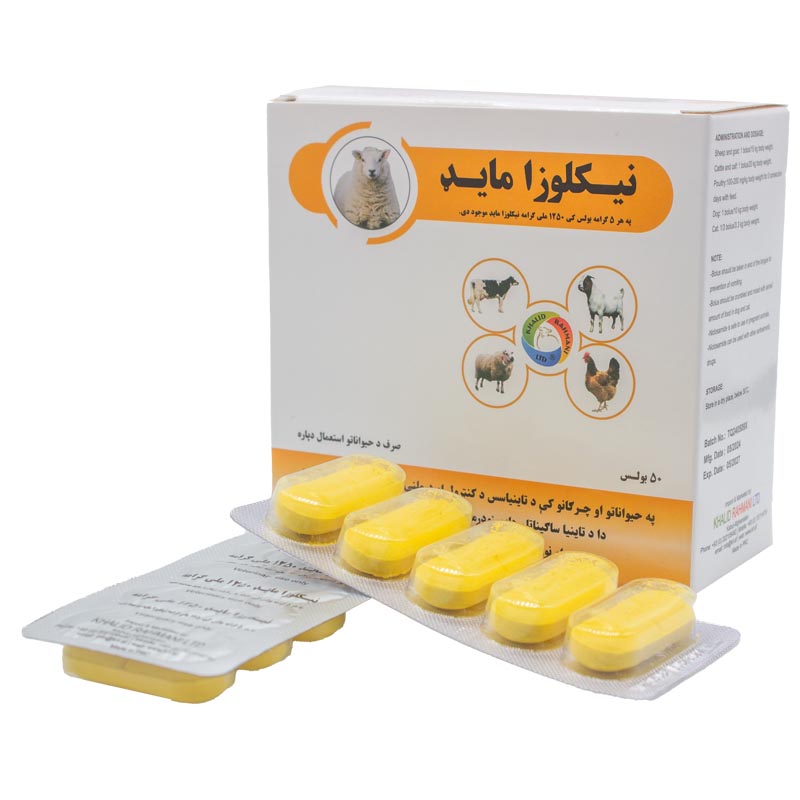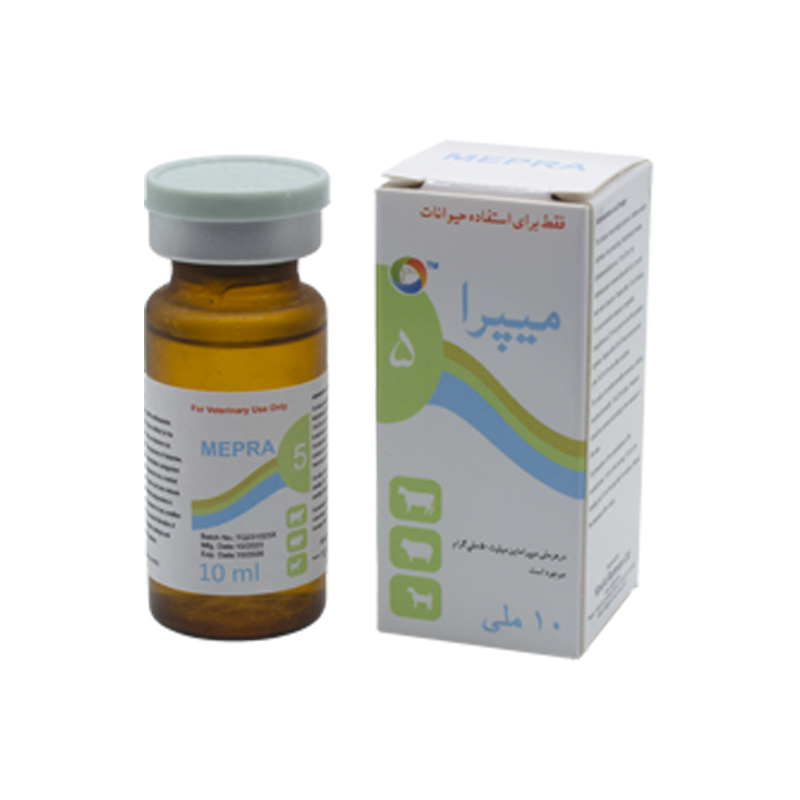Tylo Genxhapen Injection:
Composition:
10ml contains:
Tylosin…………….1500mg
Gentamycin……………….50 mg
Dexamethasone………….0.265mg
Chlorpheniromine………….75mg
Indications:
For the treatment and prevention of infections caused by tylosin and/or gentamicin sensitive microorganisms. Respiratory infections (pneumonia, bronchopneumonia), mastitis, foot rot, erysipelas, endometritis, arthritis, gastrointestinal infections in general. The dexamethasone provides an anti-inflammatory, antistress and glucogeogenic effect. The chorphenamine, as an antihistaminic, reduces allergic signs.
Dosage and Administration:
Large animals: 1ml/15 kg of b.w. every 24 hours for 3 consecutive days by deep intramuscular route.
Poultry: 1ml/6 kg
Apply through subcutaneous or intramuscular route.
Withdrawal period:
Meat: 21 days after the last application.
Milk: 4 days after the last application.
Storage:
Seal and protect from light.
Keep out of reach of children.
Packaging
10ml/bottle
Terramycin LA Injection
Terramycin LA Injection
Active Ingredients:
Oxytetracycline 20% is indicated in cattle, horse sheep and goat diseases. Many of the pathogens involved in animal disease are known to be susceptible to oxytetracycline such as digestive, skin, lungs, urogenital and septicemic pathogens.
Dosage:
Administer by deep intramuscular injection at a single dose rate of 1ml per 10 kg of body weight.
This dosage can be repeated after 48 hours when necessary. It is recommended in cattle that not more than 5ml, be injected at any on site. In young lambs for the short-term control of tick born fever and tick pyoemia a 2ml dose should be used per lamb.
Caution:
Occasi and sensitivity reaction to oxytetracycline have been known to occur. In such cases, administer epinephrine immediately.
Withdrawal time: Meat: 14 days, Milk 72 hours.
Terramycin Gold LA
Terramycin Gold La
Composition:
Each ml contains: Oxytetracycline 300mg and Flunixin meglumine 20mg.
Indications:
For the control and treatment of infectious diseases of cattle caused by or associated with organism’s sensitive to oxytetracycline, where concurrent analgesic, anti-inflammatory, anti-endotoxic or antipyretic therapy is desired.
The product is especially indicated for the treatment of respiratory disease (particularly that associated with Mannheimia and Pasteurella infection) and acute mastitis (in conjunction with appropriate intermammary therapy).
Administration and Dosage:
For intramuscular injection.
Cattle: one dose: 1ml/15-30 kg body weight daily.
Adverse Reactions:
Prolonged use of NSAIDs, including flunixin, may predispose or lead to gastrointestinal ulceration.
Reports of adverse reactions associated with oxytetracycline administration include injection site swelling, restlessness, ataxia, trembling, swelling of eyelids, ears, muzzle, anus and vulva (or scrotum and sheath in males), respiratory abnormalities (labored breathing,), frothing at the mouth, collapse and possibly death. Some of these reactions may be attributed either to anaphylaxis (an allergic reaction) or to cardiovascular collapse of unknown cause.
Special Warnings:
Do not administer other NSAIDs concurrently or within 24 hours of each other.
Do not inject more than 20 ml intramuscularly at a single site.
Withdrawal Period:
Meat: 28 days.
Do not use in cattle producing milk for human consumption.
Storage:
Seal and protect from light in a cool place. Keep out of reach of children.
Shelf Life:
3 Years.
Sulphadimidine Bolus
Sulphadimidine Bolus
Composition:
Each bolus contains sulphadimidine 600mg.
Clinical Pharmacology:
Sulphadimidine bolus has a wide range of antimicrobial activity against both positive and gram-negative bacteria. In general sulfonamides exert only bacteriostatic effect, and cellular and humoral defense mechanism of the host are essential for the final eradication of the infection.
Sulphadimidine is a structural analog and competitive antagonistic of Para-Amino Benzoic Acid (PABA) thus prevent normal bacteria utilization of PABA for the synthesis of folic acid. More specifically sulfadimidine is competitive inhibitor of dihydropteroate synthetize, the bacteria enzyme responsible for the incorporation of PABA into dihydropteroic acid, the immediate precursor of folic acid. Sensitive micro-organisms are that synthesize, their own folic acid, bacteria that can utilize performed folate are not affected.Bacteriostasis induced by sulphadimidine bolus do not affect mammalian cells by these mechanisms, since they require performed folic acid cannot synthesize it.
Pharmacokinetics:
All sulfonamides are bound in varying degree to plasma proteins, particularly to albumin. The extent to which this occur is determined by the hydrophobicity of a particular drug and its Pka; at physiological pH, drugs with a high Pka exhibit a low degree of protein binding and vice versa.
Sulphadimidine is distributed throughout all tissues of body; readily pass through the placenta and each the fetal circulation. The concentration attained in the fetal tissue are sufficient to cause both antibacterial and toxic effects.
Sulphadimidine is eliminated from the body partly as the unchanged drug and partly as the metabolic products.
The largest fraction is excreted in the urine, and the half-life of sulphadimidine in the body is thus dependent on renal function.
In acid urine, sulphadimidine is insoluble and may precipitate causing crystalline deposits that can cause urinary obstruction (crystalluria). Small amounts are eliminated in feaces and in bile, milk and other secretions.
Indications:
Is used in sulphadimidine-sesitive infections. It’s active against aerobic gram-positive cocci and some rods and many gram-negative rods including Enterobacteriaceae.
Sulphadiidine bolus is also active against Chlamydia, toxoplasma, and Coccidia.
Contraindications:
Renal or hepatic impairment, sulfonamides hypersensitivity, blood dyscrasias.
Side Effects:
Occasional crystalluria (ensure adequate water intake to the sick animal)
Withdrawal Period:
Cattle/calves slaughter 8 days: should not be used in cattle producing milk for human consumption.
Dosage:
Sheep/cattle: Initial dose 2 bolus for 50 kg and second dose 1 bolus for 50 kg for two days.
Presentation:
5 bolus/blister, 10 blisters/box
Storage: Store below 30 C in cool and dry place. Protect from light.
Keep out of reach of children.
PenStrep 400 Injection
PenStrep 400
Composition:
Contains per ml:
Procaine penicillin G 200 mg
Dihydrostreptomycin sulphate 200 mg
Description:
Procaine penicillin G is a small-spectrum penicillin with bactericidal action against mainly Gram-positive bacteria (like Streptococci, Staphylococci, some Corynebacteria spp., Erysipelothrixrhusiopathiae, Clostridia spp., Bacillus anthracis) and Gram-negative cocci, Leptospiracanicola, Campylobacter foetus and Actinomycesbovis.
Dihydrostreptomycin, an aminoglycoside antibiotic, has bactericidal activity against mainly Gram-negative bacteria, like E. coli, Proteus vulgaris, Brucella spp., Salmonella spp., Shighella spp., Klebsiella spp., Pasteurella spp. And some Mycoplasmas. The combination acts additive and in some cases synergistic.
Indications:
Penstrep 20/20 Inj. Is effective against infections caused by micro-organisms susceptible to penicillin or dihydrostreptomycin, like respiratory, uterine and alimentary infections, metritis, mastitis, osteomyelitis, peritonitis, septicaemia, cystitis, joint-ill and secondary bacterial infections in cattle, horses, pigs, foals, calves, sheep and goats.
Contra-indications:
Don not administer to animals hypersensitive to penicillin, aminoglycosides and/or procaine. Do not administer to animals with an impaired renal function, disturbances of auditory or vestibular organs. Don not use in small herbivores like rabbits, chinchillas and guinea pigs, not for prolonged use in pregnant animals because of the risk of toxicity to the foetus.
Side-effect:
Prolonged administration of high doses may result in renal, vestibular and/or auditory dysfunctions sometimes.
Incompatibility with other drugs or substances:
Penstrep 20/20 inj. Is incompatible with fast-acting bacteriostatic antimicrobial drugs (e.g. Tetracyclines, chloramphenicol, erythromycin, lincomycin) and with anaesthetics or other neuromuscular blocking agents (because of respiratory depression and apnoea).
Dosage and administration:
For intramuscular injection. Shake well before use.
General dose: 1ml per 25 kg bodyweight daily, during 3-4 days. In severe cases this dose may be doubled.
Withdrawal period:
Meat: 10 days
Milk: 3 days
Storage:
Store in a dry, dark place between 8 C and 15 C.
Keep medicine away from children.
Parallix Injection 5%
Parallix injection 5%
Contains per ml:
Buparvaquone …………. 50 mg
Indication:
For treatment of tick-transmitted theileriosis caused by the intracellular protozoan parasites Theileria parva (East Coast fever, Corridor disease, Zimbabwean theileriosis) and T, annulata ( tropical theileriosis) in cattle, it is active against both schizont and piroplasm stages of Theileria spp., and may be use during the incubation period of the during the incubation period of the disease, or when clinical signs are apparent.
Withdrawal Times:
For meat: 42 days
For milk: 2 days.
Dosage:
For intramuscular injection.
The general dosage is 1 ml per 20 kg body weight. In severe cases the treatment may be repeated within 48-72 hours. Don does not administer more than 10 ml per injection site.
Successive injections should be administered at different sites.
Storage:
Dark at room temperature (15-25C)
Oxy 5 Injection
Oxy 5% Injection:
Indication:
Oxy5 is a broad-spectrum antibiotic with bacteriostatic action against large number of gram-positive and gram-negative organisms. Rickettsia, Leptospira, Mycoplasmas, Chlamydia, Actinomyces and some protozoa. Activity against Pseudomonas-, Proteus-, ans Klebsiella spp. Is low.
The bacteriostatic effect is based on the inhibition of the synthesis of bacterial proteins.
After parenteral application, oxytetracycline penetrates very quickly into the blood and the tissues, producing high concentrations there. Since a relatively large percentage of oxytetracycline is bound to serum proteins therapeutic levels remain in the body for fairly long times, and therefore one injection per 24 hours’ ins sufficient.
Indicated with infections caused by microorganisms susceptible to oxytetracycline, like respiratory infections, gastro-enteritis, metritis, mastitis, salmonellosis, dysentery, foot rot, sinusitits, urinary-tract infections, mycoplasmas, CRD (chronic respiratory disease), blue comb, shipping fever, and liver abcesses.
Contra-Indication:
Hypersensitivity to tetracyclines, liver or renal insufficiency, combination with penicillin or cephalosporins.
Side Effects:
Hypersensitivity reactions, intestinal disturbances, local tissue reactions after intramuscular injection in horses or foals and seldom a severe, eventually fatal enteritis may occur in horses.
Dosage and Administration:
General dose 10-20 mg/kg body weight daily. Adult animal: 2ml/10 kg bodyweight daily.
Adult animal: 2ml/10kg body weight
Young animal: 4ml/10 kg body weight daily.
The dose may be repeated 3-4 days if necessary.
Withdrawal time:
14 days before slaughtering and 4 days before milking.
Storage:
Keep closed in a cool and dry place, away from sunlight and safe from children.
N-Roxin Injection
N-Roxin Injection
Composition:
Each ml contains:
Enrofloxacin ……………..100mg
Indication:
N-Roxin is a sterile, ready to use injectable antimicrobial solution that contains Enrofloxacin, a broad spectrum fluoroquinolone antimicrobial agent. N-Roxin is indicated for the treatment of Bronchopneumonia and other Respiratory tract infection, gastronenteritis, calf scour, Mastits, Metritis, pyometritis, skin and soft tissue infection, ear infection, secondary bacterial infection caused by E.coli, Salmonella, pseudomonas, streptoccus, Bordetella brochiseptica and klebsiella.
Dosage:
Administer the following dose by IM or S/C Route.
Calves, Cattle, Sheep and Goat:
1ml per 20-40 kg body weight for 3-5 days.
Poultry:
0.1ml per 2kg body weight
Pets:
0.1ml per 2kg body weight
Withdrawal period:
Don not use meat for 14 days.
Don not use milk for 4 days.
Storage:
Protect from direct sunlight and store below 30C.
Neclozamyid Bolus
Neclozamyid Bolus
Composition:
Each 5 gram Bolus contains 1250 mg niclosamide.
Indication:
Niclosamide Bolus is indicated in both tapeworm infestation of live stock, Poultry, Dogs and Cats and also in immature paramphistomiasis ( Amphistomiasis) of cattle, Sheep and Goats.
Tapeworms:
Cattle, Sheep, Goats and Deer: Moniezia species Thysanosoma (Fringed Tape worms)
Dogs: Dipylidium Caninum, Taenia Pisiformis T. hydatigena and T. taeniaeformis.
Horses: Anoplocephalid infections
Poultry: Raillietina and Davainea
Amphistomiasis: (Immature Paramphistomer)
In cattle and sheep, Rumen flukes (Paramphistomum species) is very common. Whereas the adult flukes attached to the rumen wall could be of little significance, the immature ones are seriously pathogenic causing heavy damage and mortality while migrating in the duodenal wall.
Animals showing symptoms of severe anorexia, increase intake of water, and watery fetid diarrhea should be suspected for amphistomiasis and immediately treated with Niclosamide Bolus to prevent death and loss of production since Niclosamide Bolus provides consistently very high efficacy against the immature flukes.
Administration and Dosage:
Sheep and goat: 1 bolus/15 kg body weight.
Cattle and calf: 1 bolus/20 kg body weight.
Poultry: 100-200 mg/kg body weight for consecutive days with feed.
Dog: 1 bolus/10kg body weight.
Cat: 1/3 bolus 3.3 kg body weight.
Note:
_ Bolus should be taken in end of the tongue for prevention of vomiting.
_ Bolus should be crumbled and mixed with a small amount of food in dog and cat.
_ Niclosamide is safe to use in pregnant animals.
_Niclosamide can be used with other antherlmintic drugs.
Mepra Injection
Mepra
Indication:
Mepyramine is specific antihistaminic substance which has an affinity for the same cell receptors as histamine but doses not elicit the responses of histamine. IN appropriate concentrations antagonism to histamine, mepyramine has a marked local anaesthetic action and also reduces capillary permeability. Mepyramine is indicated in the treatment of any condition associated with excessive liberation of histamine, especially is allergic and hypersensitivity reactions.
Administration and Dosage:
For shocks, hemorrhagic purpura, urticarial, serum sickness, food poisoning, Anaphylactic shocks, photosensitization etc, 10 to 20 ml, via intramuscular in several sites with 5 to 10 ml for each site of injection. Repeat after 8 to 10 hours and give and give 10-20 ml the day after, as above.
For uveitis, dermatitis verrucosa, urticarial, recurrent dermatitis, 10 to 20 ml daily. Treatment should be continued according to the evaluation of the case. For prevention of the complications of the neurectomies, 10 ml in the morning, 10 ml in the evening and 10 ml the day after the surgery. Repeat the treatment after 4 days.
